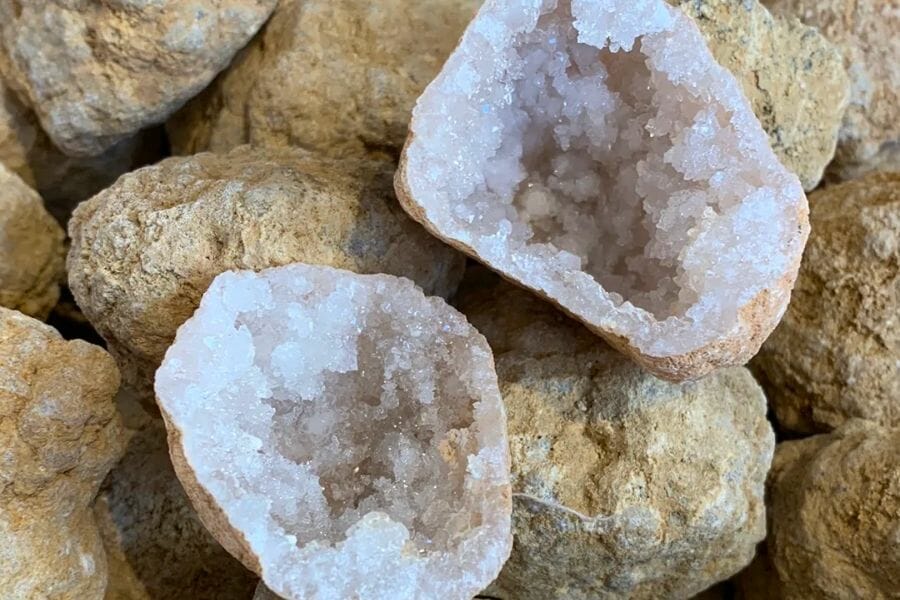Geodes are like nature’s surprise eggs, filled with sparkling crystals inside a plain-looking rock. Our state is a treasure trove for these hidden gems, with its many different landscapes that make it perfect for rock hounds.
If you’re itching to crack open your own crystal-filled wonder, you’re in the right place!
This article will show you the best spots in our state to find geodes. We’ll also share some handy tips to make your geode hunting adventure a success.
So grab your hammer and get ready to discover the beauty hiding in ordinary-looking rocks all around this state!
How Geodes From Here
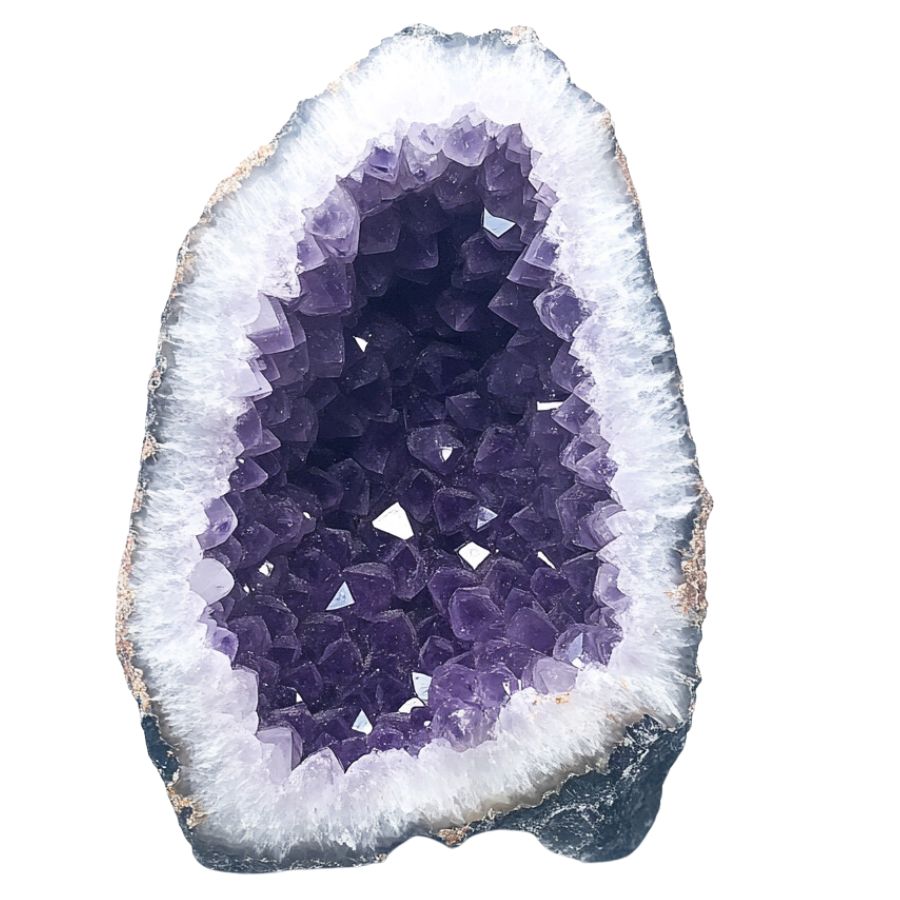
Geodes form when bubbles in volcanic rocks or spaces in sedimentary rocks get filled with minerals over time.
First, water rich in minerals like quartz or calcite seeps into the hollow space. As the water evaporates, it leaves behind the minerals, which slowly build up layer by layer.
Eventually, these minerals create a crystal lining inside the geode. The outer shell stays rough, while the inside becomes a sparkling treasure.
The process can take thousands, even millions, of years, making each geode a unique and beautiful time capsule of Earth’s natural forces.
The Types Of Geodes Found in the US
There are many fascinating varieties of geodes that can be found across the United States, including in our own state. Each type is distinctly beautiful and intriguing:
Amethyst Geode
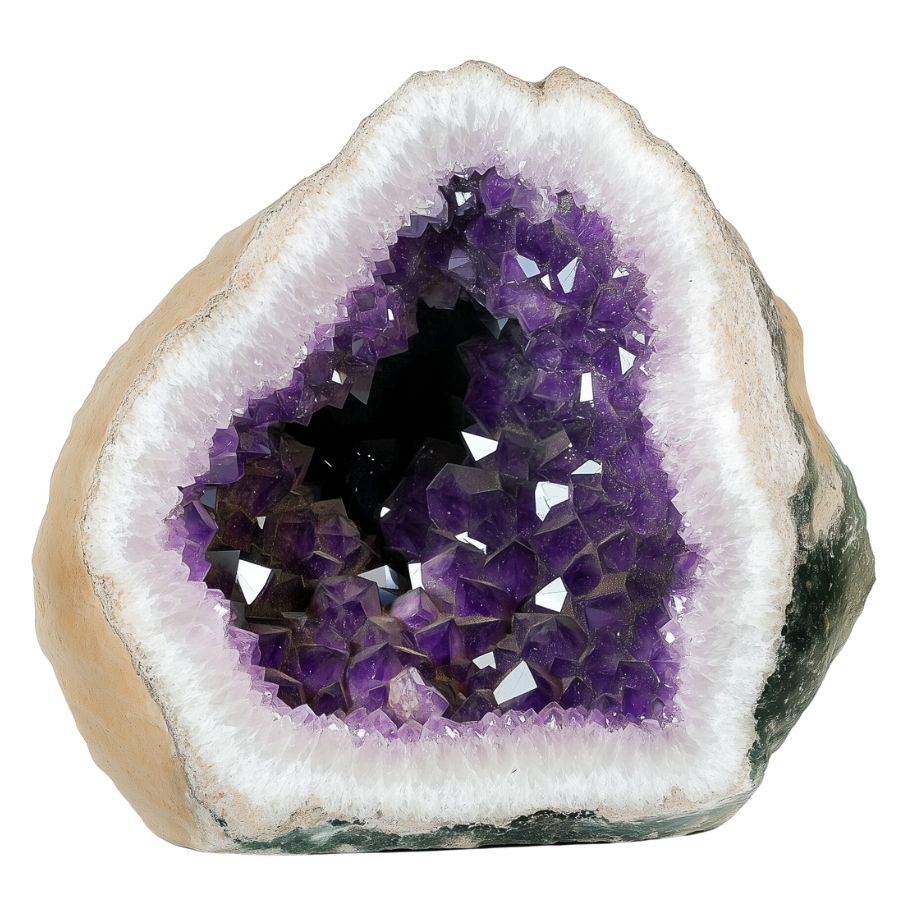
Amethyst geodes look plain on the outside, like a potato. But crack them open, and you’ll find stunning purple crystals. These crystals can be light lavender or deep purple.
The structure of crystals inside can vary widely. Some are tiny and densely packed, creating a sparkling surface. Others form large, distinct points that jut inwards.
The color range is impressive too, from pale lilac to deep royal purple. Some amethyst geodes develop unique features. “Stalactites” of amethyst might hang from the top.
In rare cases, you might find a water bubble trapped inside, a remnant from the geode’s formation millions of years ago.
Citrine Geode
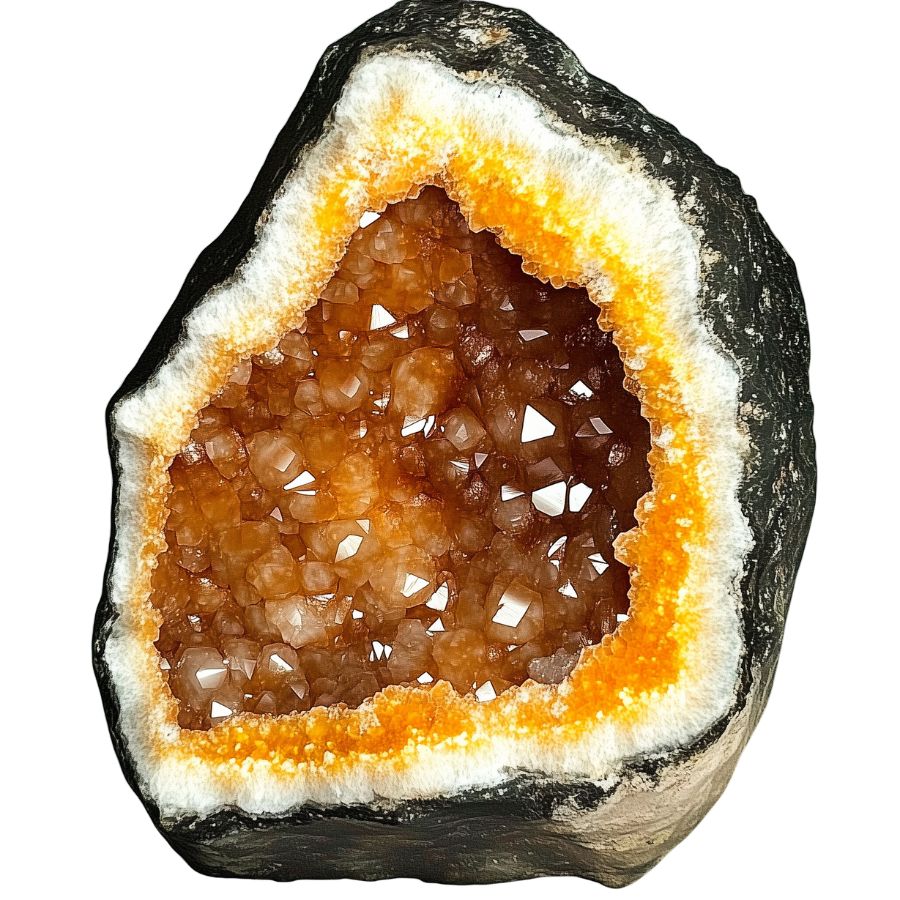
Citrine geodes are eye-catching rocks with golden yellow to orange crystals inside. They sparkle when light hits them, looking like sunshine trapped in stone. The colors come from iron mixed in with the quartz.
Unlike many gemstones, citrine’s color is often evenly distributed throughout the crystal.
Most citrine on the market isn’t natural. It’s actually heat-treated amethyst. This process turns the purple amethyst into vibrant citrine. Natural citrine is rarer and often has a more subtle color.
Pyrite Geode
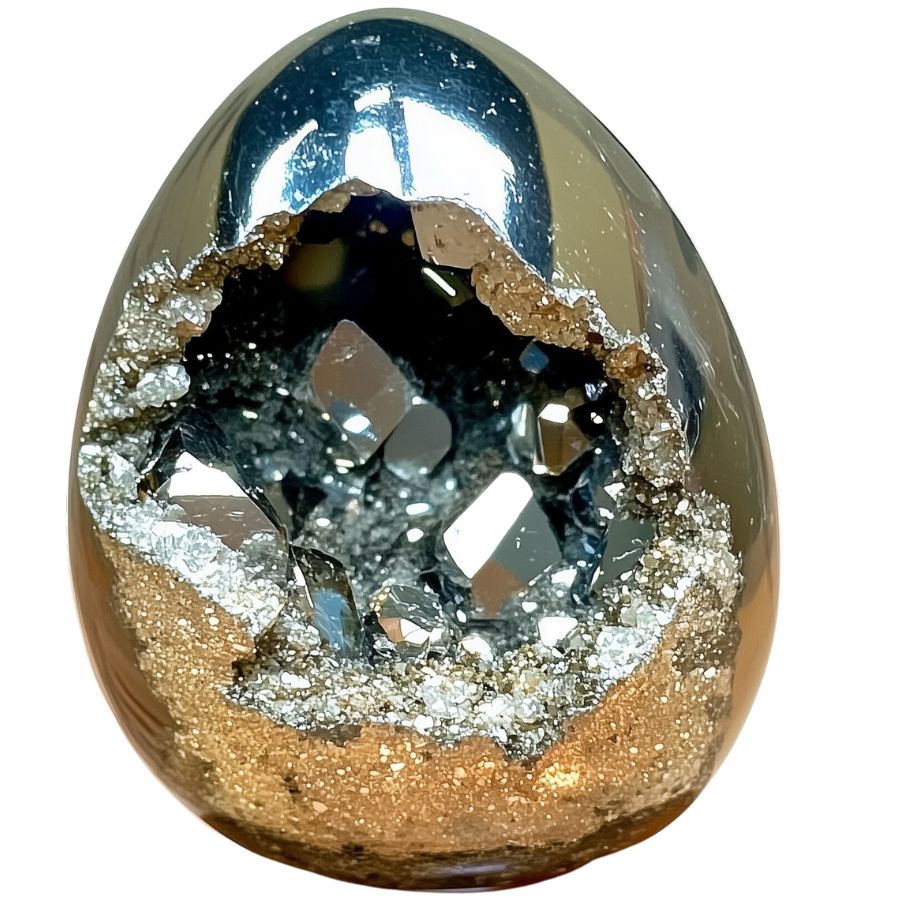
Ever cracked open a rock and found gold inside? Well, not real gold, but something that looks just like it. That’s a pyrite geode. Pyrite is called “fool’s gold” because it’s so shiny and golden.
Inside these geodes, pyrite forms in cool shapes. Sometimes it’s perfect cubes. Other times its clumps or even round balls called “pyrite suns”.
Pyrite has a fun history. People have been mixing it up with real gold for thousands of years. That’s how it got its nickname.
Selenite Geode
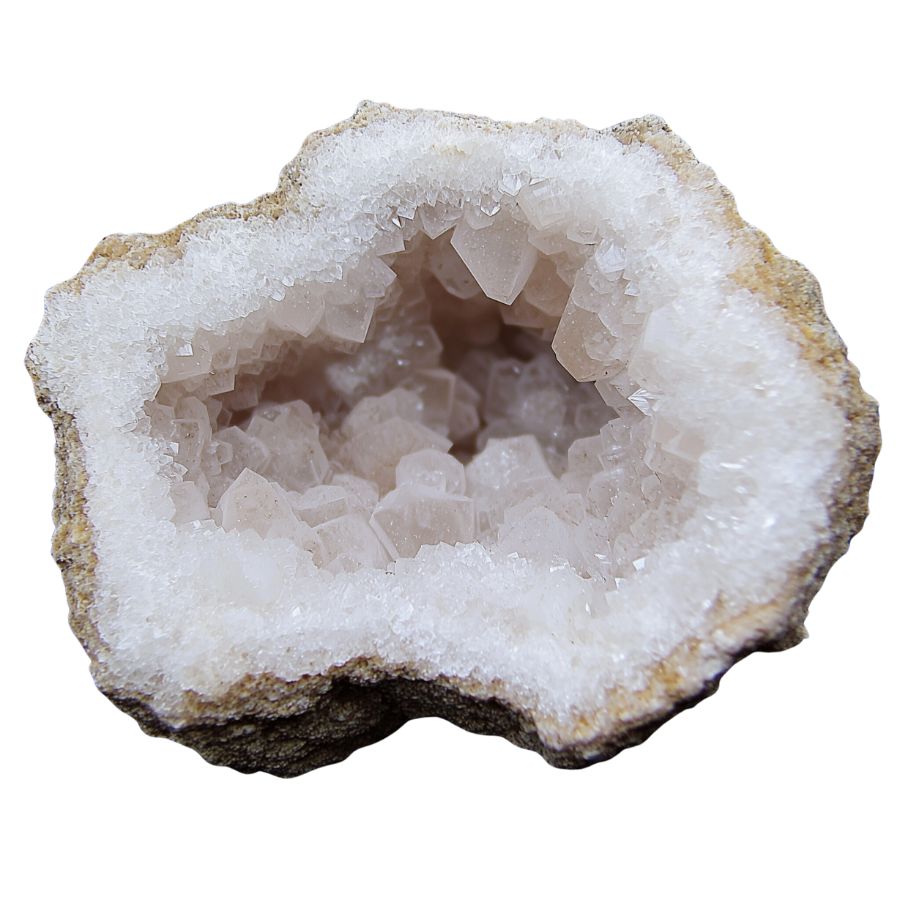
Selenite geodes stand out from the crowd. They’re white and see-through, with a glassy look. When you open one up, you’ll see crystals that look like they’re made of ice or moonlight.
Unlike harder geodes, selenite is soft. You can scratch it with your fingernail! This softness means you need to handle it carefully. But it also means selenite can be shaped into beautiful forms easily.
One cool thing about selenite is how it plays with light. Hold it up to a lamp, and you’ll see the light shine right through it. This makes selenite geodes popular for decorative lamps and light fixtures. They add a magical glow to any room.
Celestite Geode
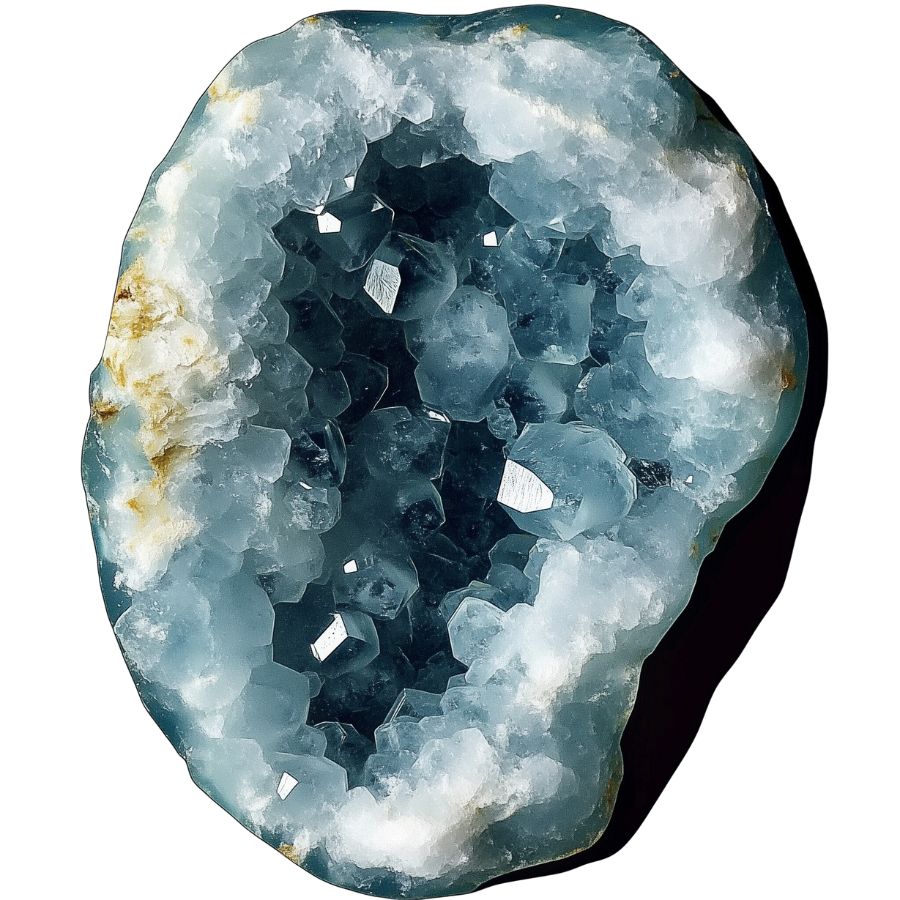
Celestite geodes are like pieces of sky trapped in rock. Their crystals are typically a delicate blue, ranging from almost colorless to deep sky blue. In rare cases, celestite can form in other colors. Pink celestite is highly prized by collectors.
One unique feature of celestite is its perfect cleavage. This means the crystals can be easily split into rhombohedral shapes.
These geodes form in a unique way. They start as nodules of a soft mineral called alabaster. Over time, this dissolves and is replaced by celestite crystals. Some celestite geodes are huge, like the famous Crystal Cave in Ohio.
Celestite isn’t just pretty to look at. It’s used to make strontium, an element with many uses. You’ll find strontium in fireworks, where it creates red colors. It’s also used in making TV screens and ceramics.
Jasper Geode
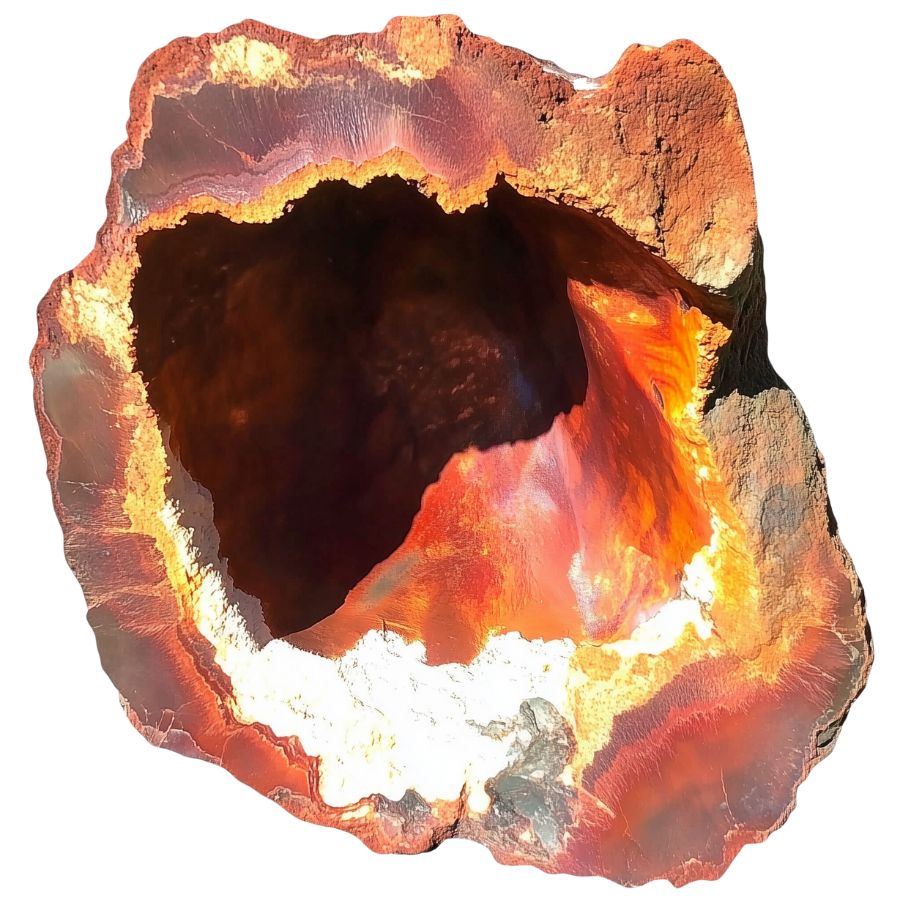
Jasper geodes are the chameleons of the mineral world. They can appear in almost any color, often with multiple hues in a single specimen. Patterns can range from solid colors to intricate swirls, bands, or spots.
One fascinating type is picture jasper. These geodes contain patterns that resemble landscapes, with “skies,” “mountains,” and “rivers” visible in the stone. Each one is like a miniature painting created by nature.
Some jasper geodes contain orbicular patterns – spherical structures that formed as the jasper solidified. These create eye-catching bull’s-eye or flower-like designs in the stone, making each piece truly one-of-a-kind.
Carnelian Geode
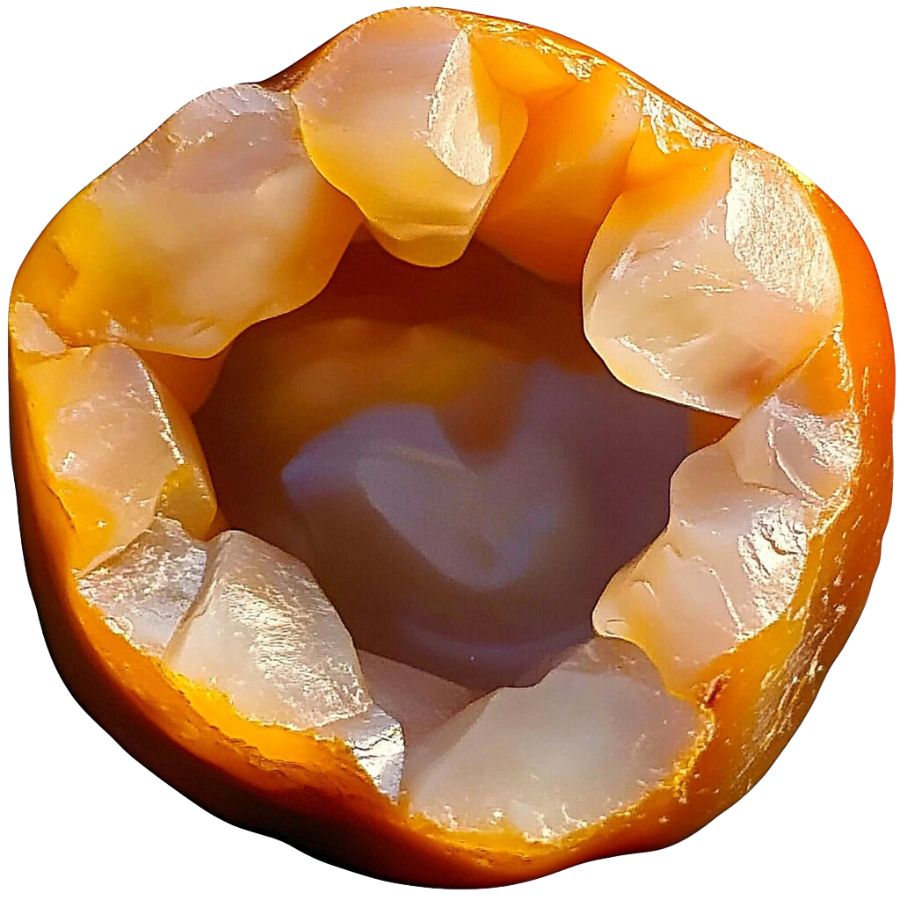
Carnelian geodes have vibrant orange to reddish-brown colors. They can be somewhat see-through, which makes them look even more interesting. The bright colors come from the iron in the stone.
These geodes stand out from other similar stones. They’re brighter than sard, which is usually darker and more brownish. And unlike agate, carnelian doesn’t have bands or stripes.
Carnelian has been popular for a long time. Ancient Egyptians and Greeks used it to make special rings. It’s tough enough for everyday jewelry.
Some people heat or dye carnelian to make its color even brighter. This makes it a favorite for both rock collectors and jewelry lovers.
Fluorite Geode
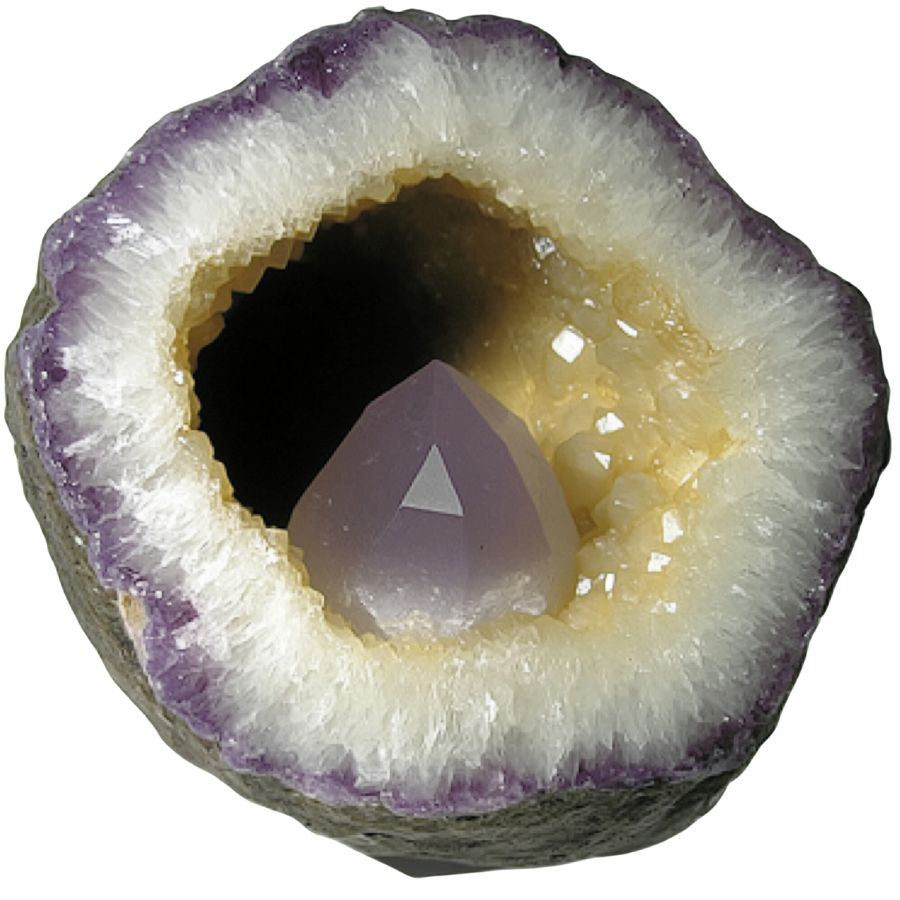
Fluorite geodes are like nature’s rainbow. They come in many colors – purple, green, blue, yellow, and sometimes even clear or black. When you open one up, you might see cube-shaped or eight-sided crystals inside.
What makes fluorite special is that you can often see more than one color in a single stone. This is different from many other geodes. Also, fluorite has a unique way of splitting when it breaks.
A cool fact: fluorite glows blue under ultraviolet light. This was first discovered back in 1852. Because of its many colors and this glowing ability, fluorite is sometimes called the “most colorful mineral in the world.”
Scolecite Geode
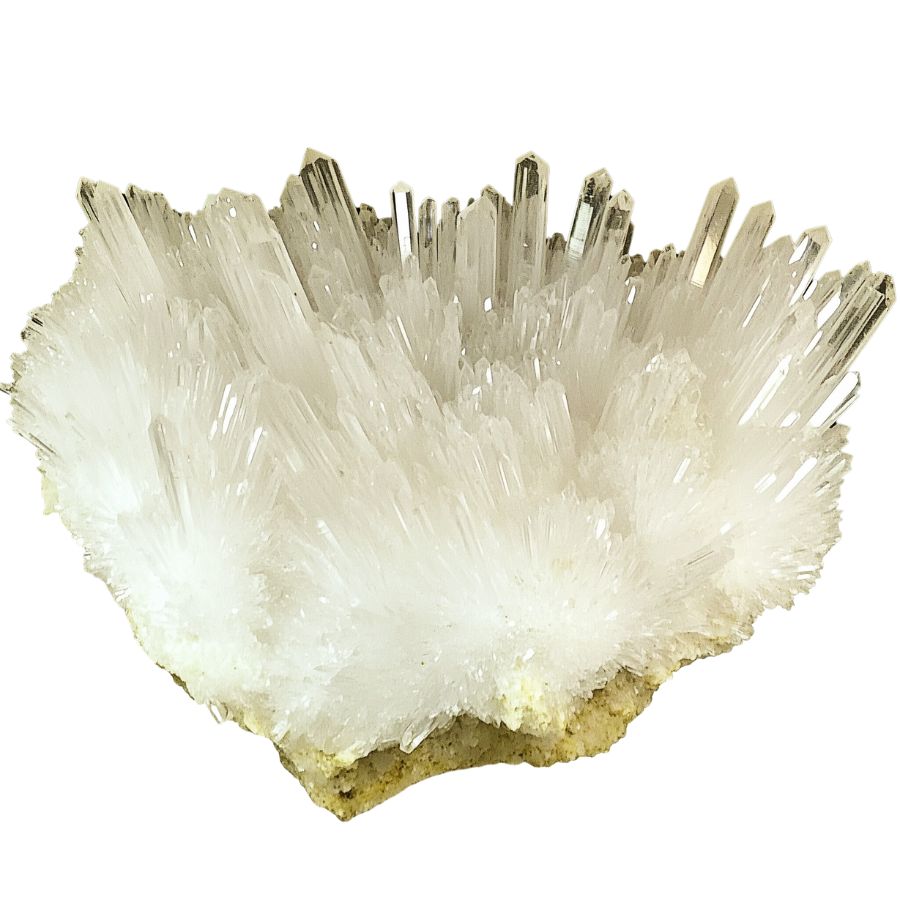
Scolecite geodes are like tiny crystal caves. They’re usually white or colorless, but sometimes you might find pink, yellow, or green ones.
What makes them special is the crystals inside. They look like thin needles or delicate hairs, all pointing out from the center.
These geodes are different from others because of their crystal shape. Instead of blocky or chunky crystals, scolecite has these fine, hair-like ones. This gives them a unique, delicate look.
Scolecite has an interesting property – it can hold a lot of water in its structure. This means it can absorb and release water easily. This makes scolecite useful in various ways, not just as a pretty rock to look at.
Apophyllite Geode
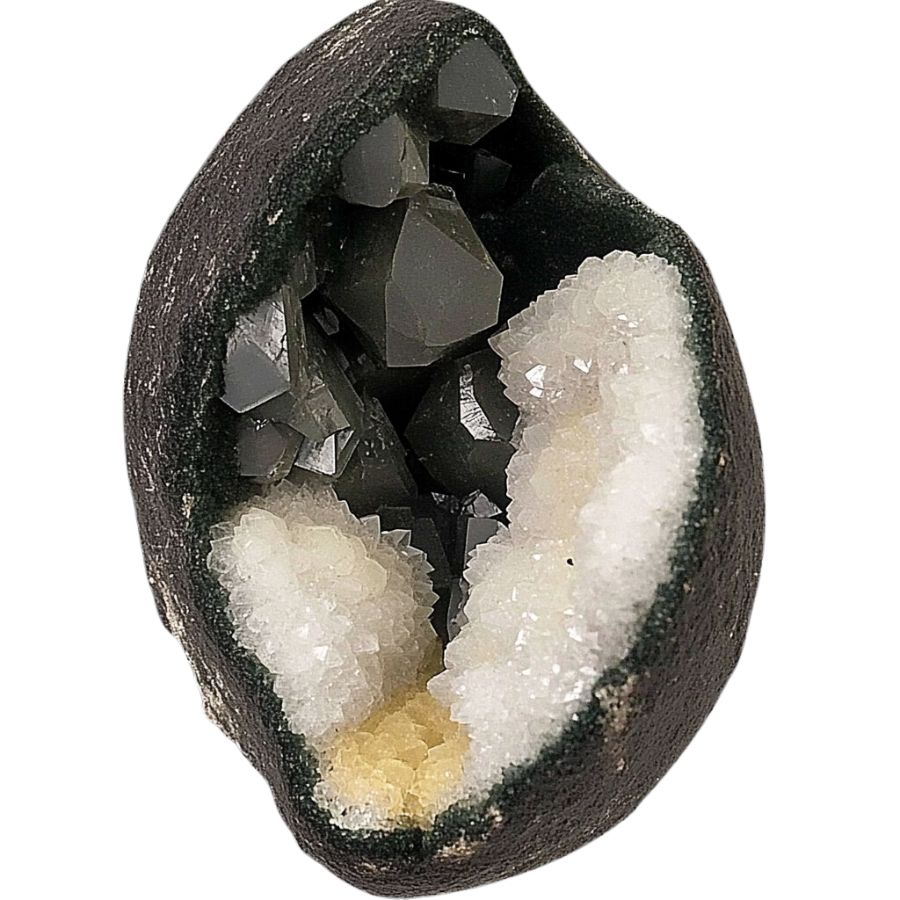
Apophyllite geodes are like nature’s disco balls. They often have dark or black crystals inside a hollow rock. These crystals can be see-through or slightly cloudy, with cube-like or flat shapes.
What makes apophyllite geodes stand out is how the crystals form. They grow in round clusters that look like tiny disco balls. This unique formation is rare and makes them special to rock enthusiasts.
Collectors really prize these “disco ball” clusters. They’re not common, which makes them valuable to people who love unusual rocks. The way apophyllite crystals catch and reflect light adds to their appeal, making them fascinating to look at and study.
What Rough Geode Looks Like
Identifying a rough geode might seem tricky, but with a few tips, you can spot one even if you’re not a rock expert. Here’s how you can do it.
Look for a Rounded Shape
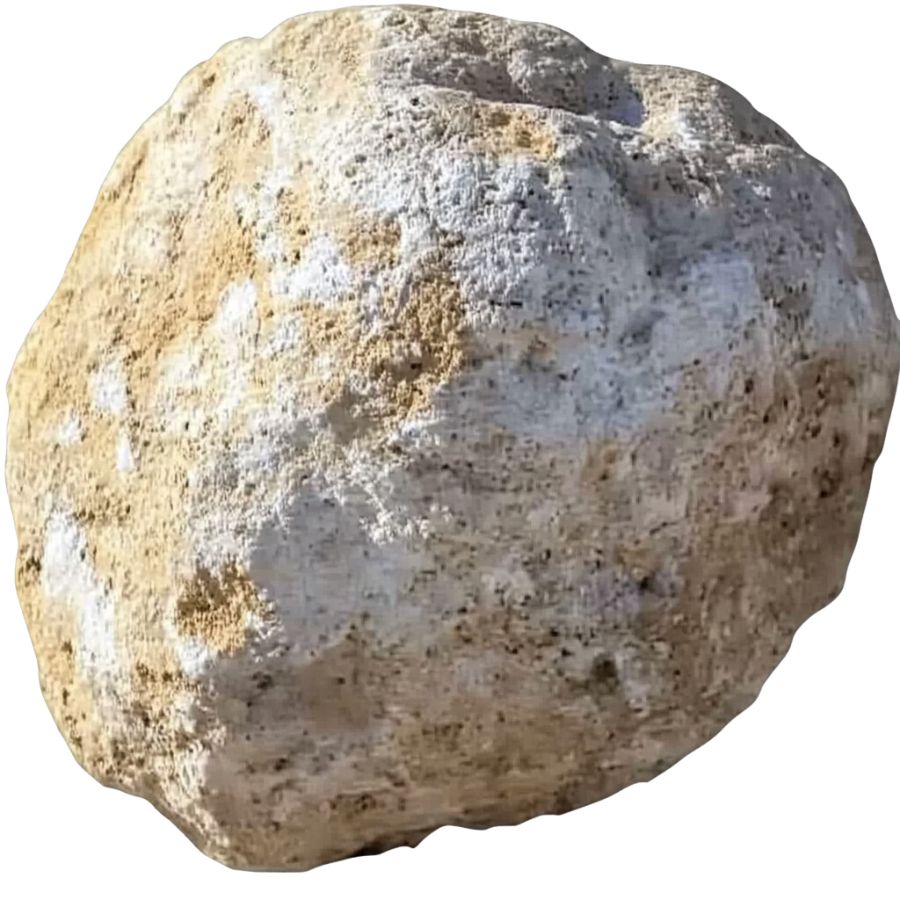
A rough geode often has a rounded or egg-like shape. It might not be perfectly round but look for a generally bulbous form.
When you’re out searching, skip the flat, jagged rocks. Geodes usually have smoother exteriors because they’ve been rolling around in rivers or other environments for a long time.
Check for a Dull, Bumpy Surface
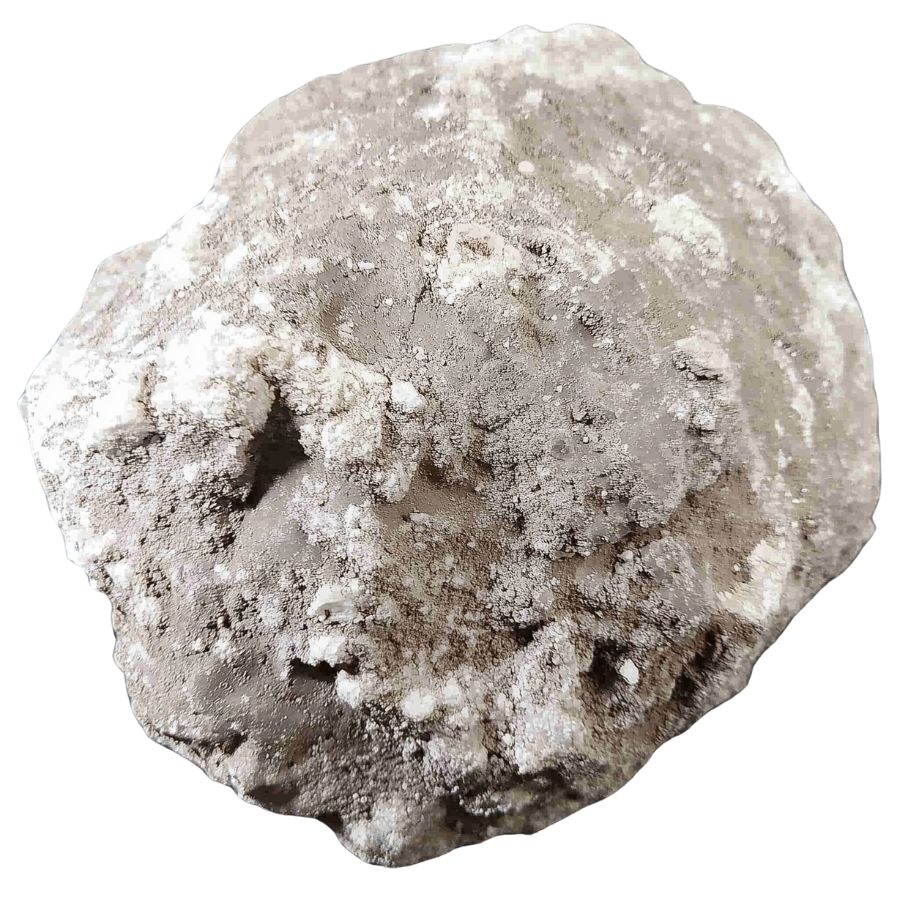
The outside of a geode isn’t usually shiny. Instead, it’s dull, bumpy, and a bit rough.
Imagine a potato or a clump of dirt with some bumps and dents. That’s how a geode might look before it’s cracked open.
The outside won’t give away much of what’s inside, so don’t be fooled by its ordinary appearance.
Test the Weight
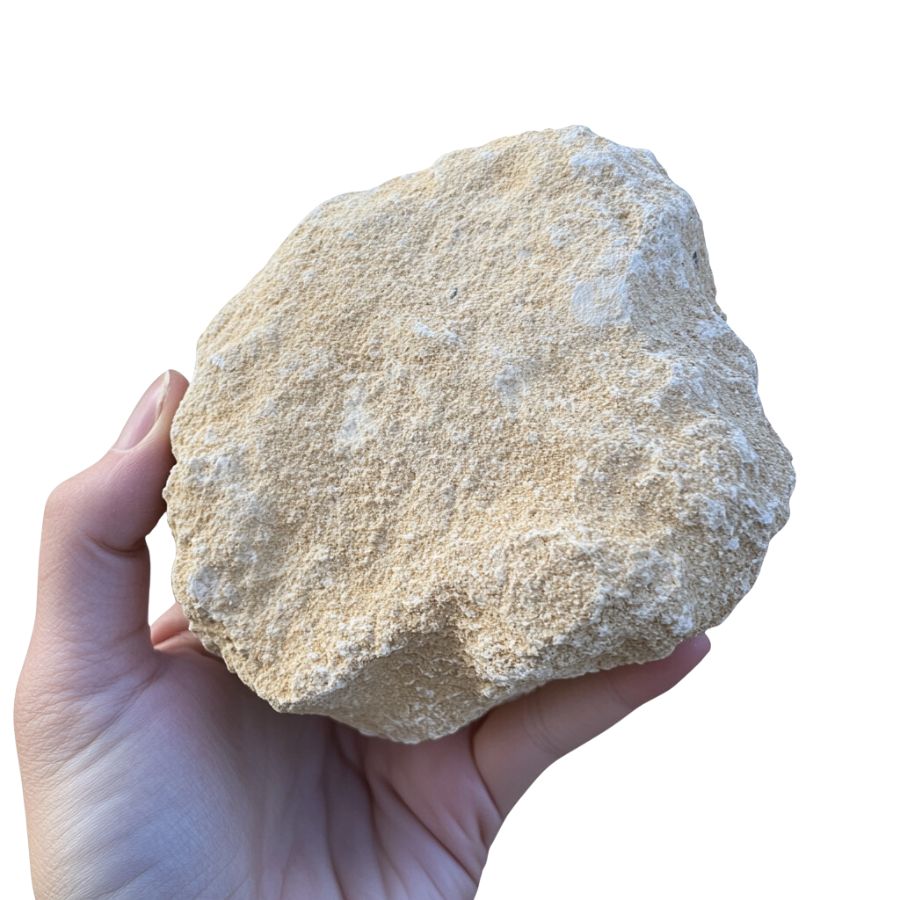
Pick up the rock. Does it feel lighter than it looks? That’s a good sign!
Geodes are hollow or partially hollow, which makes them lighter than solid rocks of the same size. If it feels unexpectedly light, you might have found something special.
Look for Tiny Crystals or Mineral Patches
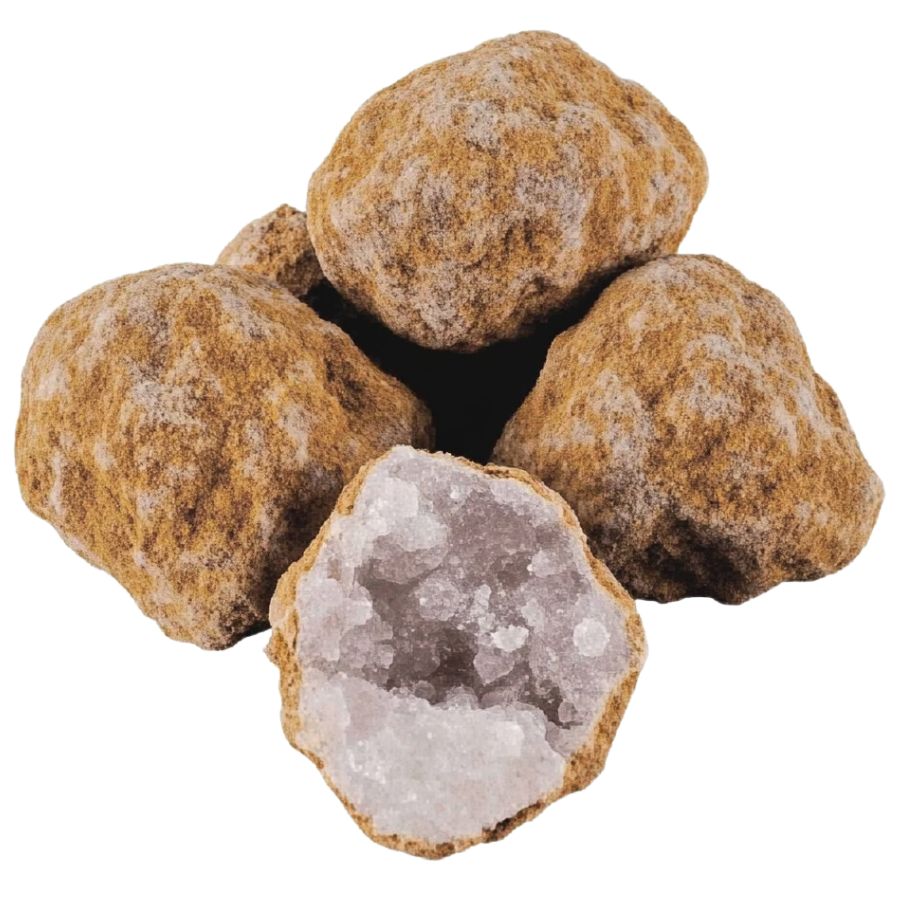
Sometimes, you can spot small crystals or mineral deposits on the outside. These could look like tiny sparkles or specks of color.
While the outside of a geode is usually dull, a little peek of what’s inside might show through. Keep an eye out for these hints, especially if you’re in a known geode-rich area.
Tips on Where to Look
Once you get to the places we have listed below there are some things you should keep in mind when you’re searching:
Explore Riverbeds and Streams
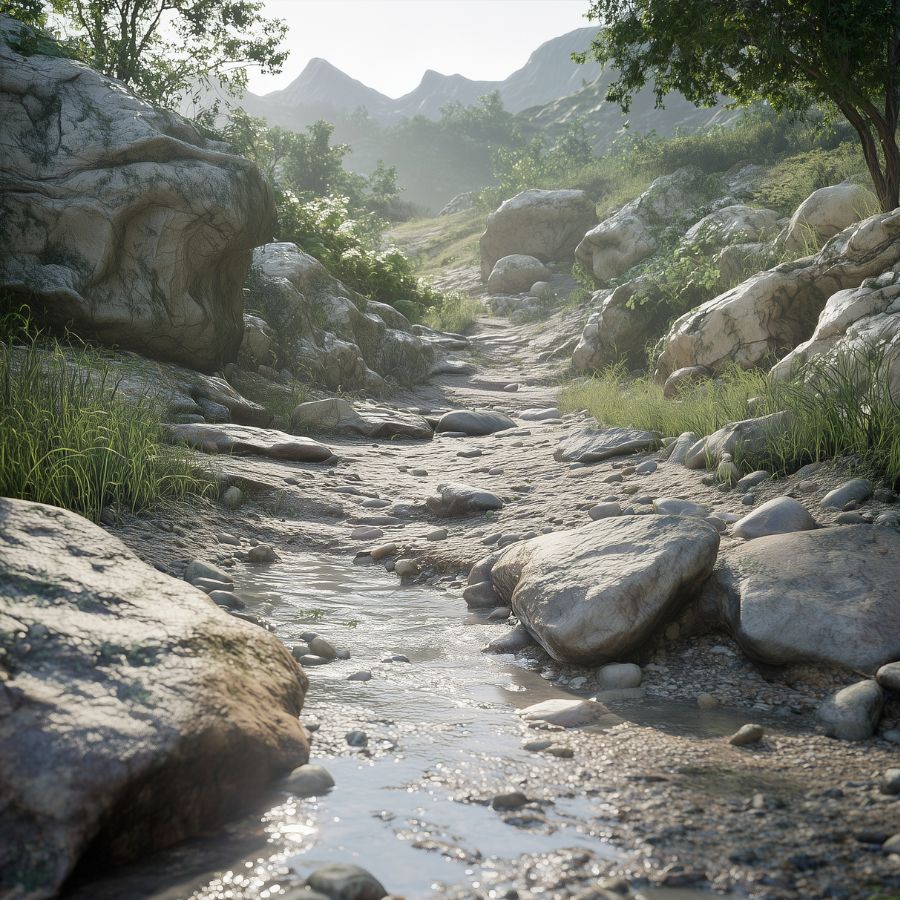
Geodes often form in riverbeds or streams. Water flow smooths out their rough edges and deposits them in these areas.
When exploring, focus on gravel bars or the edges of rivers where rocks naturally gather.
Search in Sedimentary Rock Layers
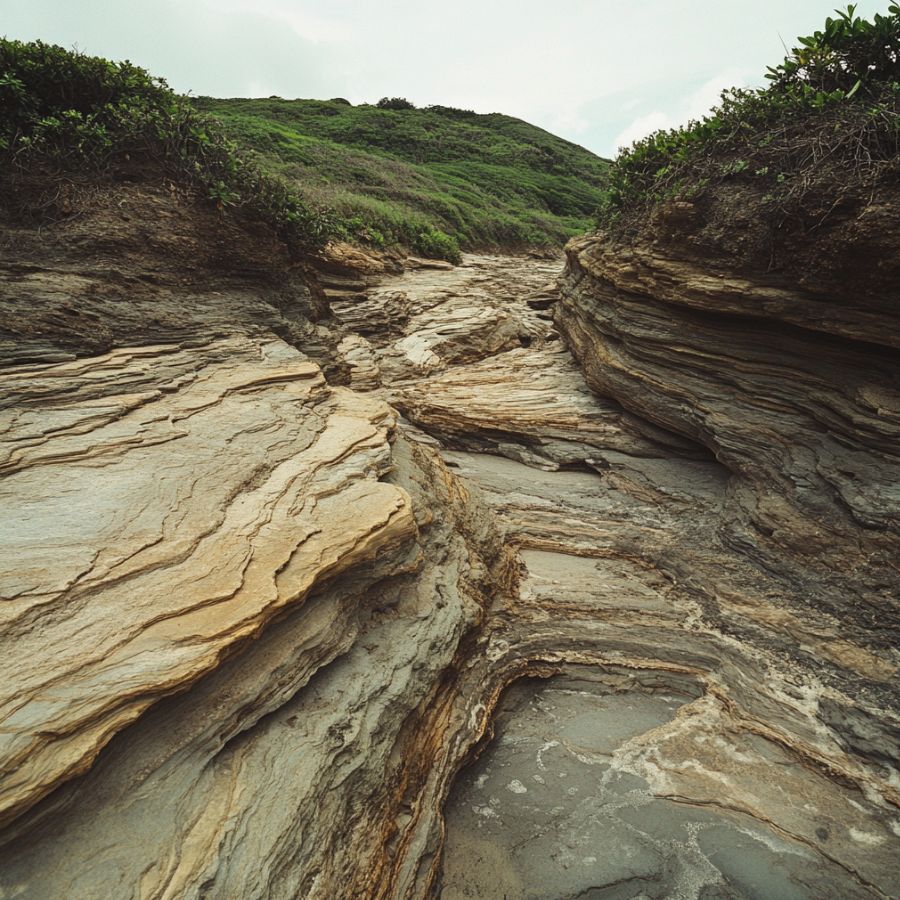
Sedimentary rocks, like limestone, are prime spots for geodes. These rocks form in layers over time, trapping minerals inside.
Look for areas where sedimentary rocks are exposed, such as cliffs or road cuts.
Visit Old Mines or Quarries
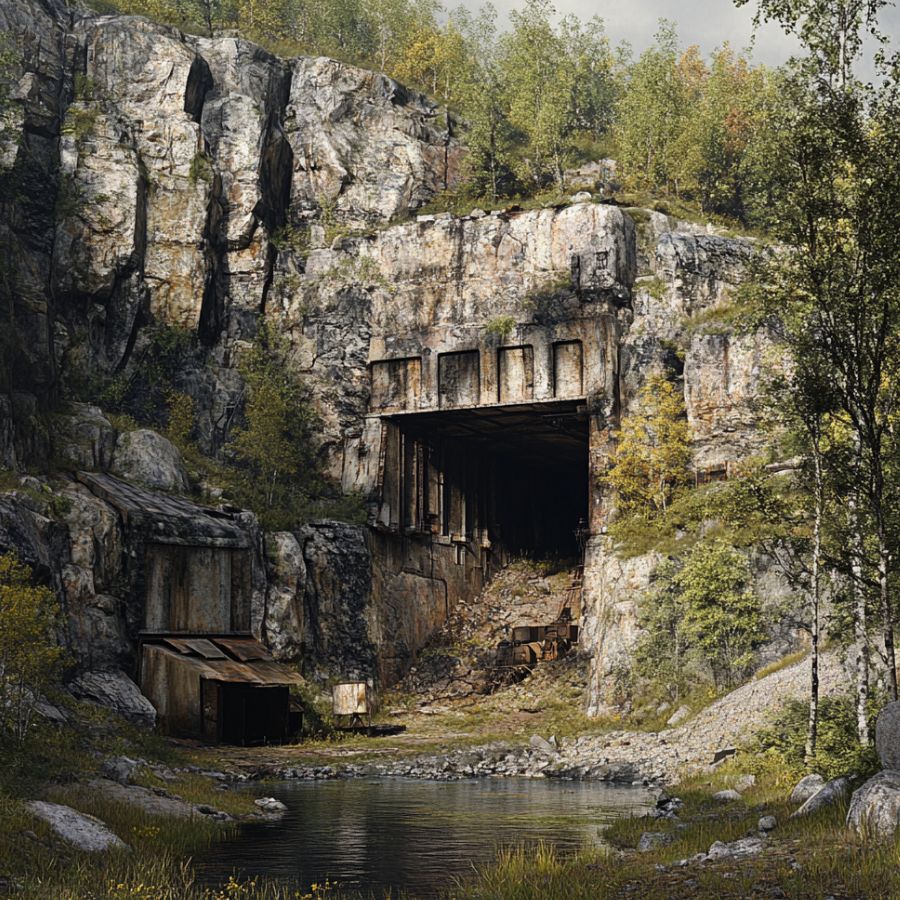
Abandoned mines and quarries are excellent spots for geode hunting.
Workers often missed geodes while digging for other materials. Explore the tailings or leftover rock piles for hidden treasures.
Explore Hills and Rock Outcrops
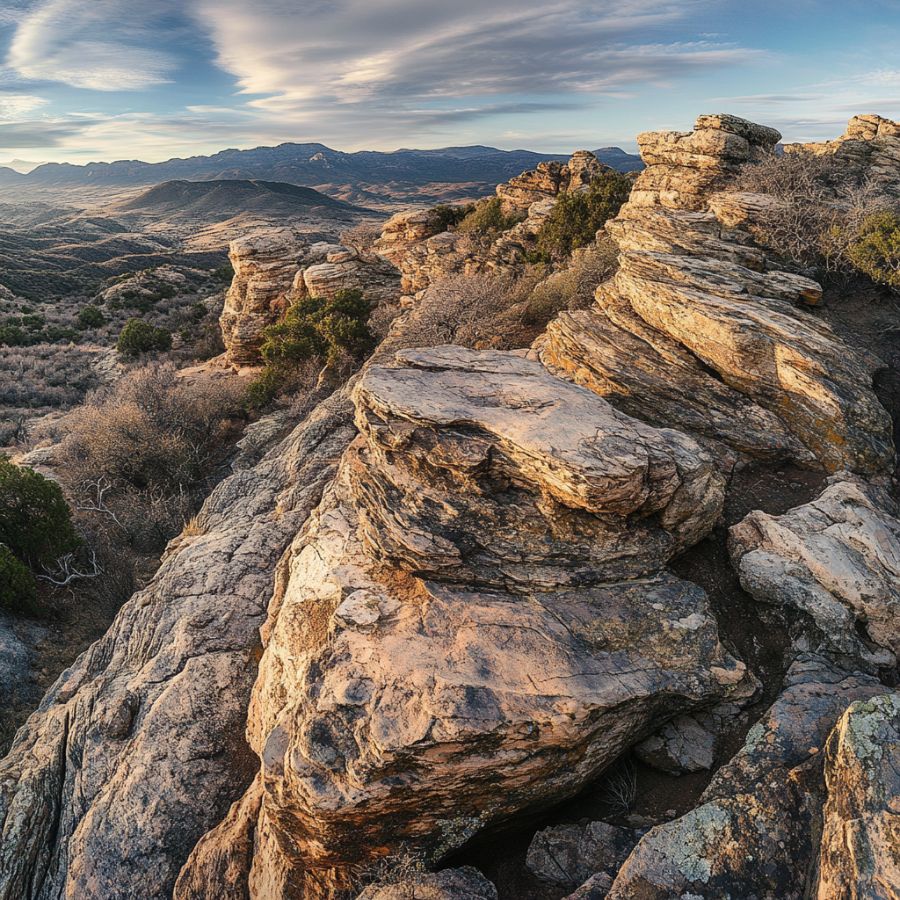
Hills and rocky outcrops often reveal geodes. As erosion wears away the softer rock, it exposes the harder geodes.
Look for areas with exposed rocks and keep an eye out for rounded shapes.
The Best Places To Find Geodes in Alabama
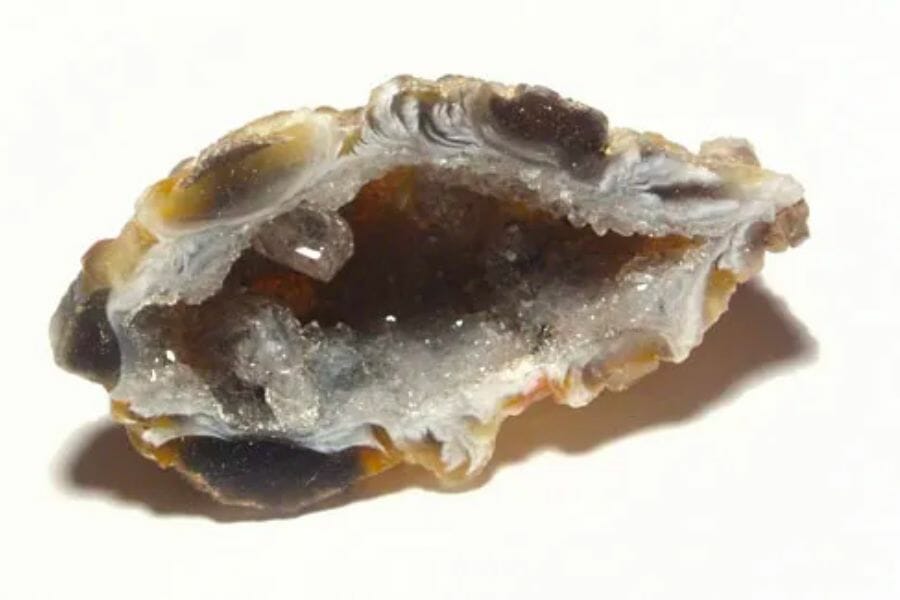
Alabama is blessed with great sites to mine gems, which you might already be aware of. However, if you’re planning to find geodes here, get ready to face some challenge because they are incredibly hard to chance upon naturally. In fact, there is currently no known spots where you can find geodes in Alabama.
Despite this, our state is endowed with so much more than geodes— we have found ideal places here where you can find rocks and gems that are just as stunning as them!
Always Confirm Access and Collection Rules!
Before heading out to any of the locations on our list you need to confirm access requirements and collection rules for both public and private locations directly with the location. We haven’t personally verified every location and the access requirements and collection rules often change without notice.
Many of the locations we mention will not allow collecting but are still great places for those who love to find beautiful rocks and minerals in the wild without keeping them. We also can’t guarantee you will find anything in these locations since they are constantly changing.
Always get updated information directly from the source ahead of time to ensure responsible rockhounding. If you want even more current options it’s always a good idea to contact local rock and mineral clubs and groups
Lake Martin
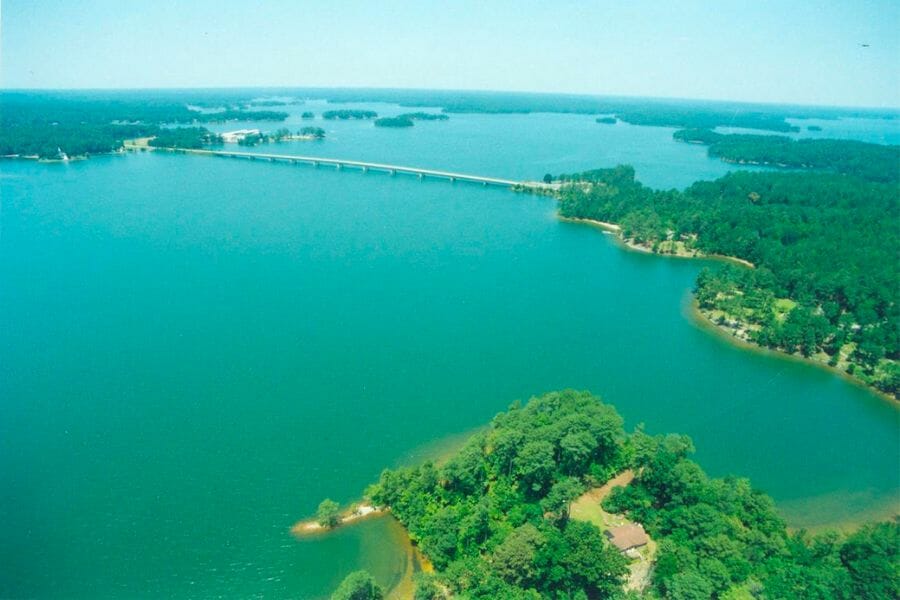
Covering over 44,000 acres, Lake Martin is one of the largest man-made lakes in the US. Located in the foothills of the Appalachian Mountains, it’s surrounded by beautiful, forested hills that offer some stunning views.
The terrain around the lake is pretty diverse – you’ve got everything from rocky bluffs to sandy beaches, and even some swampy areas. And since the area around the lake are some of the oldest mountains in the world, it has some pretty interesting rock formations, including exposed bedrock and small caves.
Getting here will take a couple of hours’ drive from Birmingham or Atlanta. But before you do any collecting here, be sure to check first the latest guidelines of Alabama.
Where we found geode-like formations
You can find a handful of fascinating geode-like formations in Lake Martin like the following:
- Actinolite, Epidote, Feldspar, Hematite, and Quartz crystals on the outcrops of Lake Martin’s west shores
- Actinolite, Feldspar, and Quartz crystals on the access areas of Lake Martin’s east shores
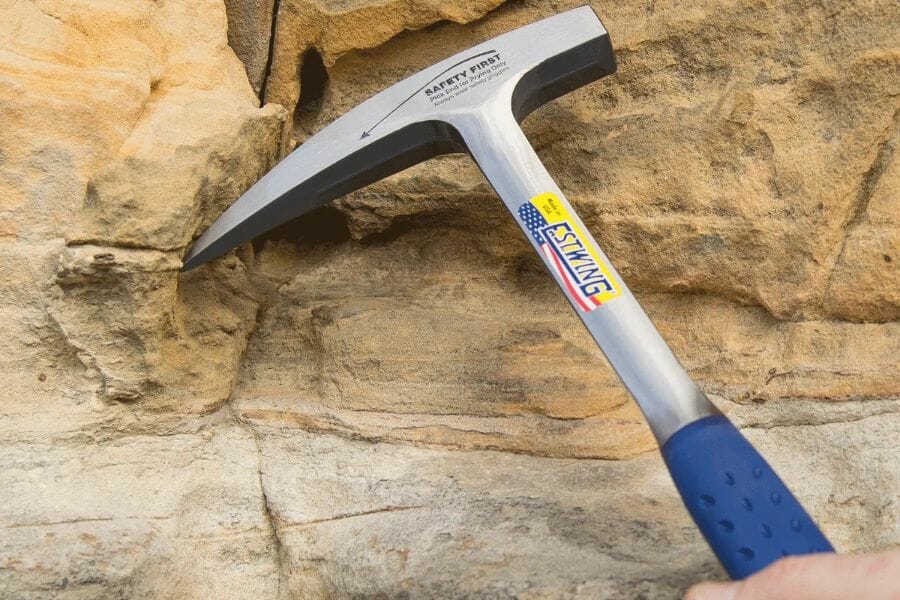
The tools every geode hunter will need
When you're out looking for geodes having the right tools for the job is very important. You don't need a lot for most trips but there are a handful that are critical and will make your life a lot easier.
We get asked a lot about the equipment we use. Over the years we've found a handful of tools that we recommend to both new and experienced geode hunters which we outline in great detail in our complete rockhounding tools and kit guide. These are quality options that also happen to be relatively inexpensive.
Below are the basic tools that make your life so much easier and save you a ton of time. Check out the full guide to see everything we recommend bringing. One quick note, as an Amazon Associate I earn from qualifying purchases but we try very hard to only recommend gear we would use ourselves and often recommend brands you can't find on Amazon.
At a minimum you should have:
1 - Sturdy rock hammer: The Estwing Rock Pick is our standard
2 - Rugged chisels: Try Kendo' 3-piece Chisel Set
3 - Compact shovel: The Koleiya 28-inch shovel works well
4 - Rock screen pan: The Wazakura Soil Sieve Set fits the bill
5 - Eye protection: DeWalt Safety Glasses are cheap and comfortable
6 - Head protection: Malta's Safety Helmet has been our go-to
7 - Jewelers lens with at least 20x magnification: Jarlink's Jewelers Loop is perfect
The geode-finding books that we use most
There are also a few books that have been extremely helpful in the search for gems. These books have great recommendations and tips:
National Audubon Society Field Guide to Rocks and Minerals: North America
Southeast Treasure Hunter's Gem & Mineral Guide
Earth Treasures: The Southeastern Quadrant
We provide links to find these tools on Amazon but some can also be found at your local hardware stores. For more recommendations check out the link to our full tool guide above.
Black Warrior River
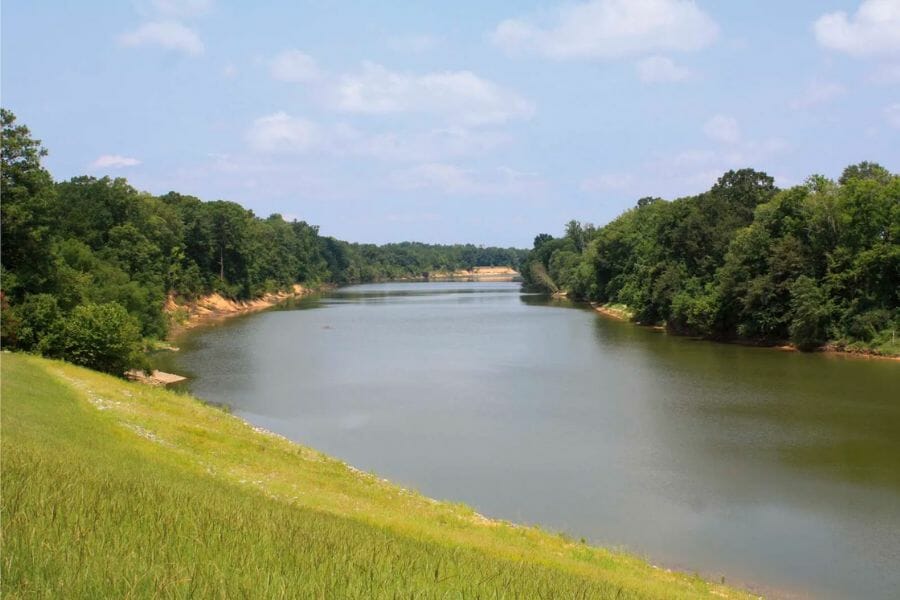
Black Warrior River stretches over 170 miles and flows through some pretty diverse terrain: rocky bluffs, sandy beaches, and wetlands. The river runs through some pretty interesting rock formations, like the Appalachian Mountains, so you’ll see exposed bedrock and some really cool rock formations along the way. You can even find fantastic Alabama crystals when you go here.
If you want to visit here, you have to drive for an hour from Birmingham. There are plenty of access points along the river, so you can choose your own adventure. You can take a leisurely float down the river, go fishing, or even do some kayaking or canoeing if you’re feeling adventurous.
One thing to keep in mind is that the river can get pretty shallow in some spots, so be careful if you’re in a motorboat. Also, watch out for some of the bigger rocks and rapids – they can be a little tricky to navigate.
Where we found geode-like formations
When you visit here, you can get on your hands on some amazing samples of Agate, Chalcedony, Jasper, Kyanite, and Vivianite on the area stream gravels, iron mines, and pits along Black Warrior River between Brookwood and Peterson.
Hog Mountain
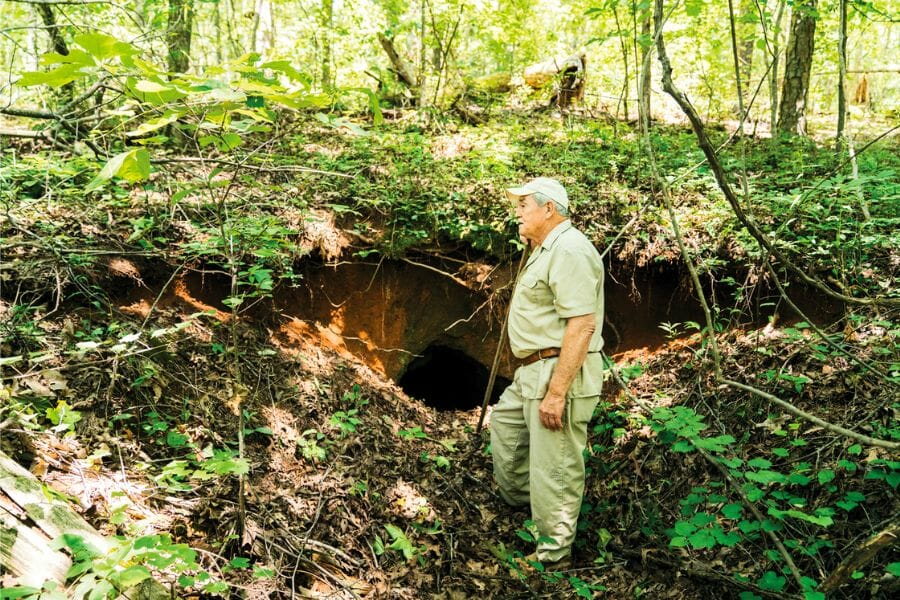
Located in the northeastern part of our state, Hog Mountain is part of the southern Appalachians. Because of this, you’ll see some exposed bedrock and interesting rock formations along the way. Its terrain is also pretty diverse. You’ll have to hike through dense forest, over rocky outcroppings, and even past a small waterfall.
Hiking up Hog Mountain is a real adventure. It’s not for the faint of heart, but if you’re up for a challenge, it’s definitely worth checking out. Its trail is steep and rocky, so be sure to wear sturdy shoes and bring plenty of water. The trailhead is a bit tricky to find, but if you ask around in the nearby town, someone will be able to point you in the right direction.
Where we found geode-like formations
You can find some amazing deposits of Quartz veins bearing Gold and Pyrite, along with other stunning gems and minerals here if you search through the northeast of Hog Mountain in Alexander City.
Mississippi River
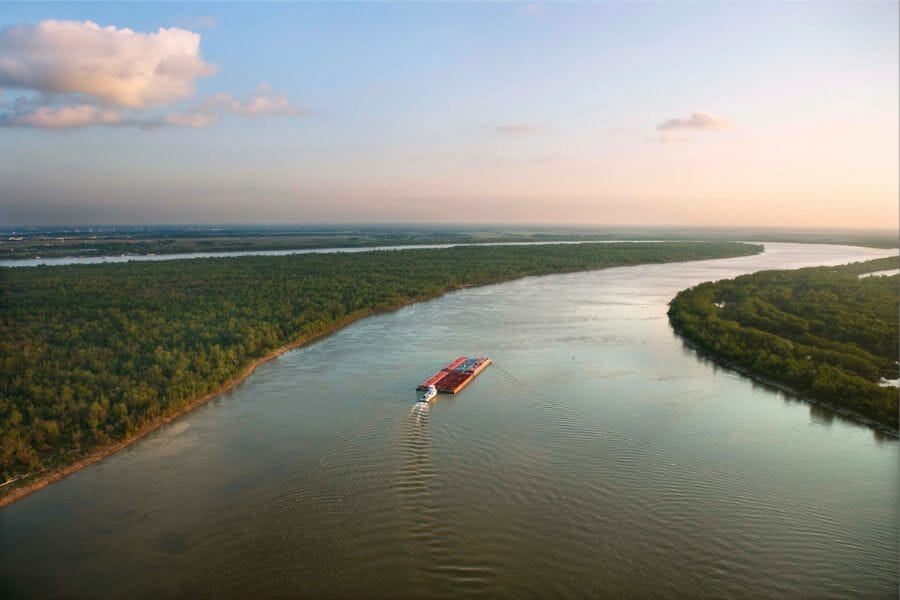
Alabama is adjacent to the beautiful state of Mississippi that has great sites to find geodes. One of them is the mighty Mississippi River, the second-longest river in the United States that stretches over 2,300 miles. Not only is it a big one, it is also an important part of American history and culture and played a major role in shaping the landscape of the region.
Over the centuries, the river has deposited sediment and carved out new channels, creating a diverse array of habitats for plants and animals. When you visit here, your eyes will have a feast over its low-lying floodplains, steep bluffs, and rolling hills of the area. You’ll also appreciate its exposed bedrock and interesting rock formations.
Since the river runs through the heart of Mississippi, it’s pretty easy to get to. It has plenty of access points for boaters, anglers, and other enthusiasts.
Where we found geodes in Mississippi River
The Mississippi River’s gravel pits and dredge tailings are the prime locations to discover geodes here. At times, geodes from other areas, such as the Keokuk Geode Beds in Southeastern Iowa, are carried downstream and accumulate on the river’s gravel bars.
Caladesi Island State Park
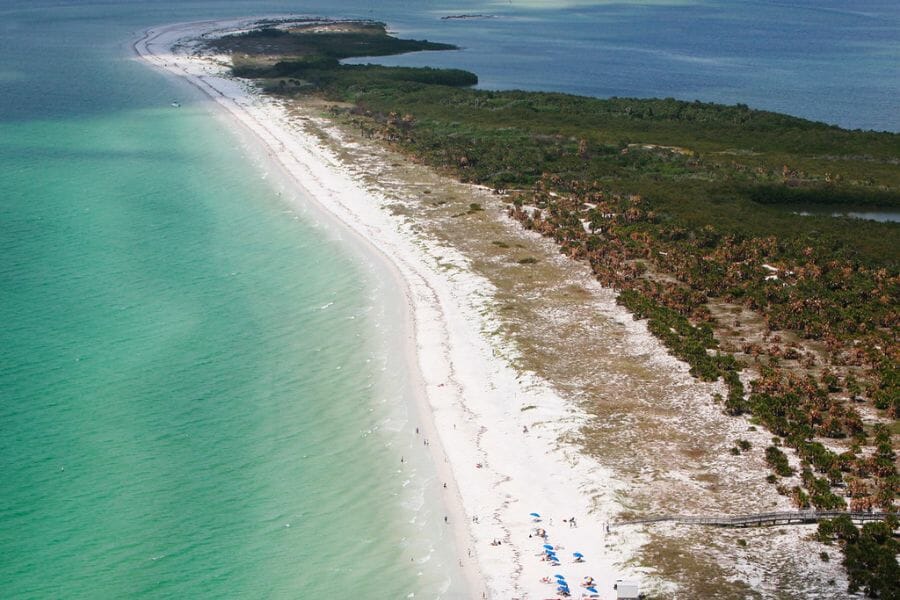
We included among our recommendations another area from a nearby state, the Caladesi Island State Park in Florida. It’s not a secret that Florida abounds in great spots to find geodes, and this recommended location is only of them.
Located just off the coast of Dunedin, Caladesi Island State Park is a unique barrier island with pristine beaches, crystal-clear waters, and some of the best shelling you’ll find anywhere in Florida. Sand dunes and coastal vegetation dominate the landscape, with plenty of nature trails and boardwalks that make exploring the island on foot very enjoyable.
Getting here is a breeze – just hop on a ferry from Honeymoon Island State Park or take your own boat over.
Where we found geodes at Caladesi Island State Park
The rocks and soils of Caladesi Island State Park contain sedimentary rock formations, like limestone, where geodes are often discovered.
Common Alabama Geode-Hunting Questions
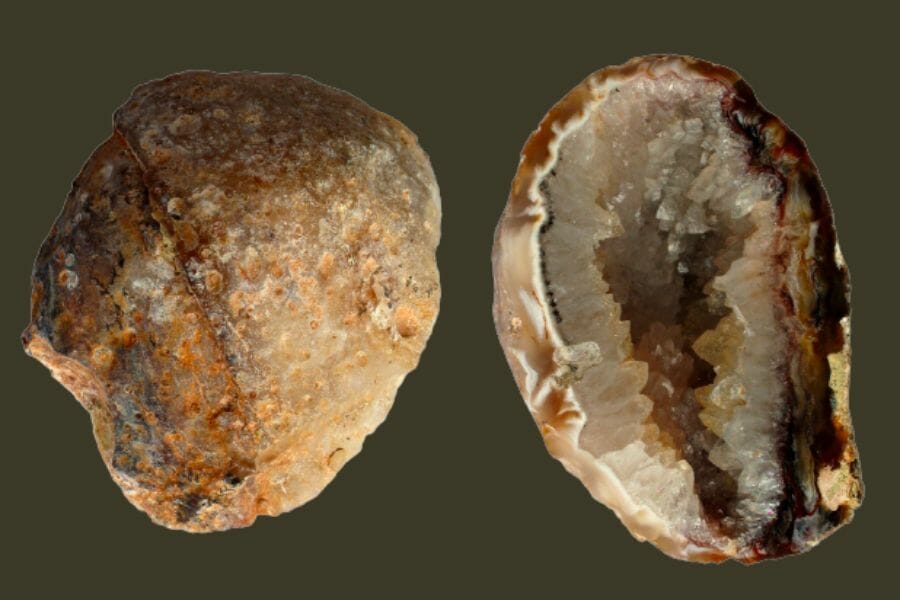
We stumbled upon some common questions that people often ask when trying to find geodes in Alabama. And we thought it would be helpful to answer them here for you.
Where can you find amethyst geodes in Alabama?
Unfortunately, amethyst geodes do not naturally occur in Alabama. There are awesome spots here, though, where you can find some beautiful amethyst crystals, like the Lowe Farm in Cherokee County.
Is it illegal to collect geodes in Alabama?
As long as you’re compliant with the local laws on collecting geodes and other natural formations, you won’t have any problem exploring Alabama for them. Make sure that you also check any existing regulations specific to the kind of land you will explore, like for government lands or private lands.
The Best Places To Buy Geodes In Alabama
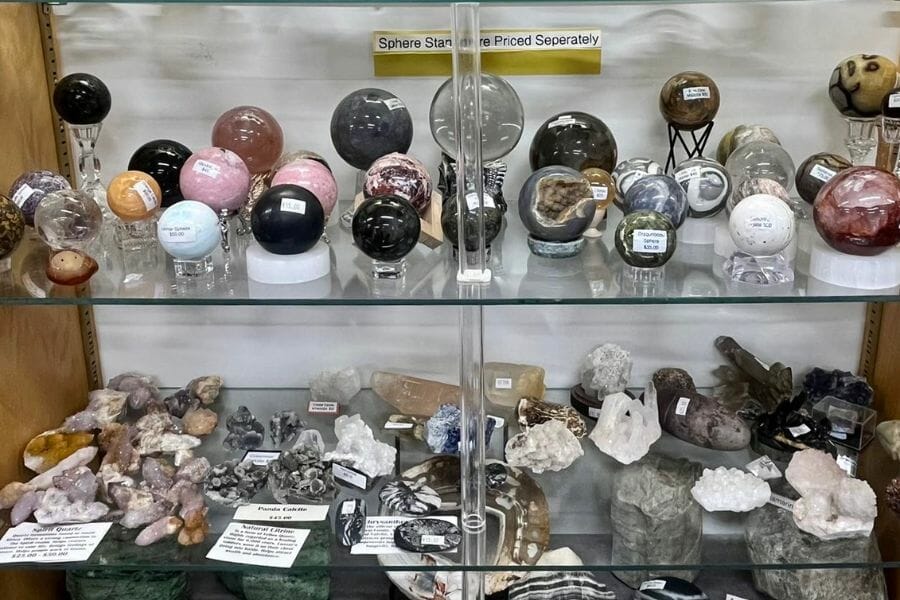
The surest way to find geodes in Alabama is by visiting the different gem and rock shops here. And since Alabama is rich with these wonders, we shortlisted the best local stores for you to choose from:
- Keepers Korner – 103 Simpson St, Florence, AL 35630
- Amazon – Did you know that Amazon has some of the best types of geodes out there? They even have whole kits to crack geodes open.
- Amethyst Sage – 1809 Hwy 31 SW, Hartselle, AL 35640
- Rough and Tumbled LLC – 189 W Reynolds St, Ozark, AL 36360
- Cosmic Connexion – 814 Annalue Dr, Auburn, AL 36830
- Conjure Fairy – 300 Hwy 78 E ste b2, Jasper, AL 35501
Additional places to find geodes in nearby states
Check out our guides for nearby states if you’ve already tried all of our suggestions above or if you’re planning a trip outside of the state:
If you have any recommendations for our list please leave a comment below!

